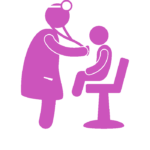DEFINITION
A Critical Value / Critical Result is defined as a value/result that represents a pathophysiological state at such variance with normal (expected values) as to be life-threatening unless something is done promptly and for which some corrective action could be taken.
SCOPE
This policy is applicable to all laboratories within Rjolad Hospital Laboratories/Erom Diagnostics.
PURPOSE
The purpose of this list is to identify the laboratory tests and their respective critical high and critical low values/results. This list pertains to testing that is performed in R-Jolad Lab/Erom Diagnostics.
Critical values may imply a life-threatening situation for the patient and must be brought to the immediate attention of the physician and/or the patient care staff responsible for the patient. Prompt notification of potentially life-threatening test results is important to ensure appropriate care is administered. Critical (panic) values are established for a normal population, though in some instances may not be considered “critical” when related to disease states. Interpretation of test results and determining if a result is critical to a particular disease state is the responsibility of the requesting physician. The purpose of this policy is to provide employees with the list of test values identified by the Laboratory Heads as potentially life-threatening.
POLICY STATEMENT
All critical values are promptly reported to the ordering provider or designee following the applicable Critical Value notification procedure(s).
Approved designees include:
- Designee listed in the Emergency Information tab.
- Nurse responsible for the patient
- Provider’s Medical Assistant (M.A.) or Health Service Coordinator
- Nurse in the same department or unit
- Health Unit Coordinator (HUC) on same unit, only if RN is not available.
- Scientist in the laboratory from which the specimen was referred (Outreach only)
Notification must include the following:
- Patient’s full name
- Medical record number (or accession number)
- Date and time of specimen collection
- Test name
- Patient test result and reference range.
- Any additional pertinent information (i.e. hemolysis, lipemia, etc.)
- Notification and verification of read back must be electronically documented in the lab information system(s). Read back documentation must include the identity (first and last name) of the person called.
- Critical results from tests which have not been ordered (e.g. platelet count on a hemoglobin test, parasite/fungal organisms on a body fluid smear prepared for a different test, etc.) are subject to the same notification and documentation.
NOTE: The critical values/results do not necessarily correspond directly with normal reference ranges, toxic ranges, or therapeutic ranges.
NOTE: In addition to the critical values identified on this list, critical alerts from testing referred to outside laboratories (non R-Jolad Lab/ Erom Diagnostics) will be communicated in accordance with notification standards once those performing laboratories notify R-Jolad Lab or Erom Diagnostics
HEMATOLOGY
| Test Report Name | Age | Critical Low | Critical High | Units |
|---|---|---|---|---|
| Activated Partial Thromboplastin Time, Plasma | – | ≥ 150 | sec | |
| Fibrinogen | ||||
| Hemoglobin | 0 – 7 weeks | ≤ 6.0 | ≥ 24.0 | g/dL |
| Hemoglobin | > 7 weeks | ≤ 6.0 | ≥ 20.0 | g/dL |
| INR (International Normalizing Ratio) | ≥ 5.0 | |||
| Leukocytes | ≥ 100.0 | x10(9)/L | ||
| Absolute Neutrophil Count | ≤ 0.5 | x10(9)/L | ||
| Neutrophils | ≤ 0.5 | x10(9)/L | ||
| Platelets, Blood | ≤ 40.0 | ≥ 1000 | x10(9)/L | |
| CSF White Blood Cell Count | ≥ 100.0 | Cells/mcL | ||
| Blast cells | ≥20 | % | ||
| All new malaria patients | POSITIVE | |||
| D-Dimers | ALL | |||
| Coombs tests | POSITIVE | |||
| HIV rapid serology testing, employee exposure | POSITIVE |
CHEMISTRY
| Test Report Name | Age | Critical | Critical High | Units |
| Urea | > 90 | mg/dL | ||
| Amylase2 | > 1000 | IU/L | ||
| C-Reactive Protein (CRP)2 | > 50 | mg/dL | ||
| Bilirubin Total, Serum | < 1 yr | ≥ 15.0 | mg/dL | |
| Calcium, Total | ≤ 6.5 | ≥ 13.0 | mg/dL | |
| Calcium, Ionized, Blood | < 1 yr | ≤ 2.0 | ≥ 6.0 | mg/dL |
| Creatinine Clearance (Urine)2 | < 80 | ml/min | ||
| Creatinine, Blood/Plasma/Serum | 1 day – 4 weeks | ≥ 1.5 | mg/dL | |
| Creatinine, Blood/Plasma/Serum | 5 weeks – 23 Mos | ≥ 2.0 | mg/dL | |
| Creatinine, Blood/Plasma/Serum | 2 yrs – 11 yrs | ≥ 2.5 | mg/dL | |
| Creatinine, Blood/Plasma/Serum | 12 yrs – 15 yrs | ≥ 3.0 | mg/dL | |
| Creatinine, Blood/Plasma/Serum | 16 yrs – 17 yrs | ≥ 10.0 | mg/dL | |
| Creatine Kinase, Total | ≥ 10,000 | U/L | ||
| FT4 (Free Thyroxine) | < 50 yrs | ≥ 7.8 | ng/dL | |
| FT4 (Free Thyroxine) | ≥ 50 yrs | ≥ 6.0 | ng/dL | |
| FT4 (Free Thyroxine) – Florida | All ages | ≥ 7.8 | ng/dL | |
| Glucose, Plasma/Serum | < 4 weeks | ≤ 40 | ≥ 400 | mg/dL |
| Glucose, Plasma/Serum | ≥ 4 weeks | ≤ 50 | ≥ 400 | mg/dL |
| Magnesium, Serum | ≤ 1.0 | ≥ 9.0 | mg/dL | |
| Phosphorus | ≤ 1.0 | mg/dL | ||
| Potassium | ≤ 2.5 | ≥ 6.0 | mmol/L | |
| Sodium | ≤ 120 | ≥ 160 | mmol/L |
MICROBIOLOGY
| Result | Specimen source and patient details |
| Detection (e.g., stain, culture, nucleic acid, antigen or metabolomic detection) of a clinically significant bacterium, | Blood/plasma/serum, cerebrospinal fluid, |
| fungus, parasite, or virus (except HIV, hepatitis A) | amniotic fluid, ocular fluid/corneal scrapings |
| Identification/detection of a select agent (or other highly pathogenic organism) including, but not limited to Bacillus Corynebacterium diphtheriae, Vibrio cholerae or Yersinia pestis In the event of an outbreak of a novel contagious microorganism, detection of such an organism may fall into this category. | |
| Positive Blood Culture | Blood |
| Detection of herpes simplex virus or COVID | Any specimen tested from a neonate (< 1 month) |
REFERENCES
- ISO 15189. ISO 15189:2012 medical laboratories requirements for quality and competence. 2012.
- ISO.Org/ISO/Catalogue_Detail?Csnumber=56115 [Fecha de consulta 22 Ene 2016].
- Plebani M. Errors in clinical laboratories or errors in laboratory medicine. Clin Chem Lab Med 2006;44:750–9.
- Mayo Clinic Laboratories Critical Values / Critical Results List.




































